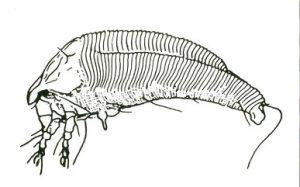What is the grapevine micro mite virus?
The grapevine micro mite virus like many other pests or diseases gets its name from the first plant where it was found. In this case, this virus caused great losses in the wine and vineyard industry. The virus comes from the bite and fluid exchange of the Calepitrimerus vitis micro mite, an eryophid mite of about 0.2mm and yellowish in color. Their eggs are round, pale in color and usually measure about 0.04mm. As you can see, the size of these individuals makes their detection impossible with the naked eye. It may happen that this infection disappears and reappears in our crops, since the females of this mite spend the winter under the scales of the buds on the thumbs and arms. During the year, several generations follow each other that will cause an increase in symptoms and a subsequent reduction.

What damage does the grapevine micro mite virus cause?
The most frequent damages and symptoms appear in the most tender shoots, in growing tips and buds. The new shoots will have a much slower growth than normal, the leaves will be twisted with bulges, very marked veins and very short internodes. In bloom, they will reduce flower production and resin production. In extreme infections there will be no production of resin, leaving the flowers as artificial and plastic. As with other diseases or pests, if we have a vigorous growth and we can make the development of the plant faster than the growth of the pest, we can harvest, although the production losses will be apparent. Often we will observe that as the leaves grow the symptoms will disappear in the large leaves already formed, but that is because the pest is in the growth buds and it is continuously moving to new shoots when they become harder. This pest prefers tender shoots. It can also be said that this mite has a select palate and a preference for some varieties or others. We have been able to verify how it clearly affected one variety and did not affect those around it until this individual was eliminated, then they decided to move to another variety.
How is grapevine micro mite virus infection spread?
Unlike most viruses that can be transmitted through tools, it seems that in this case the infection is clearly caused and spread by the micro mite Calepitrimerus vitis . If we eradicate the plague, we will end the symptoms of the infection. That means cleaning up all the remains of dead leaves or stems that may remain in the vicinity.
How do you combat the grapevine micro mite virus?
-Chemical control
Taking into account that they hibernate behind the skin of the branches, it is very difficult to act on this pest when it is in hibernation. The key moment will be when it begins to affect the buds, but without waiting until it is too late. At this time the micro mites will move from the nodes and branches to the buds, so whenever we apply a treatment we must do it thoroughly and spraying not only the underside of the leaves but also also the knots of all the branches and the path from the knots to them. As long as the size allows it, the best option is to do a dive to make sure that we arrive with the treatment everywhere. Even so, this mite tends to laugh at most products for home gardening, and the sale of strong chemicals is restricted to people who have a phytosanitary card, for which you have to take a course. Sulfur or Spirodiclofen is used very frequently for the vineyard to combat it.
-Biological control
Biological control looks for natural predators for this type of mites that have very little effect on our crops. Normally the use of predators does not completely exterminate the pest, but it will keep it in a balance that will allow us to harvest with more or less results. There are several predators among which we can highlight the phytoseidae Typhlodromus pyri, Typhlodromus phialatus or Kampinodromus aberrans. At a domestic level, this is clearly the best option and the most respectful of the environment. Whether we use chemical control or if we do it biological, if it is a mother plant, we will reduce the growth buds to one, since this way we will better locate the treatment and it will be more effective.
Prevention techniques:
-Subject to quarantine all the new acquisitions of our mothers wardrobe, mostly if we do not know their origin. -Eliminate infected varieties that we have not been able to recover and all the remains of these. -Keep the culture free of micro mites to avoid contagion from other individuals. -Keep vineyards or vine shoots away from our crops. -Never wear shoes or clothing that has come near a vineyard or vine shoot.
